1994 - 2004 Corvette - Technical Article: Run Flat Facts
Estimated Reading Time: 12 MinutesRun Flat Facts
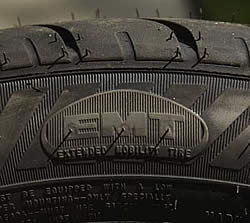 |
| Goodyear EMT tires are identified by this unique label. Image: Author |
by Hib Halverson
©2004 all rights reserved.
The first run-flat tire was developed by Goodyear in 1978. The first application of a run-flat tire on a regular production vehicle was the optional Goodyear, Eagle GS-C EMT on the 1994 Corvette. The first, standard-equipment, run-flat on any car was Goodyear’s Eagle F1 GS-EMT on the 1997 Corvette. Clearly, Goodyear and Corvette are industry leaders as far as run-flat tires go. Today, besides the Vette, the Cadillac XLR and CTS-V, the Dodge Viper, the Hummer H1 and some European and Asian cars use run-flats. There’s little question that, in the future, many more will use them. In fact, 2005 will see the first application of a run-flat on a mainstream consumer vehicle with Toyota using them on a minivan sold in the U.S.
When deflated, the EMTs on Vettes are rated by General Motors for 200 miles, in 73° weather, at 55 mph, with the car at gross weight. The damage an EMT can sustain and remain drivable for that 200 miles is pretty amazing. I remember a demo Goodyear and GM once staged. They drilled through a tire with a one-and-a-half-inch hole saw, then let media drive the car. While its ultimate run flat life is 200 miles, if an EMT suffers a repairable puncture (the hole saw stunt was decidedly not repairable), it can go 50 miles at 55mph, then be fixed and returned to service. Depending on the size and location of the puncture, a repaired EMT’s speed rating may be reduced.
I was first exposed to these run-flats while working on an piece for Corvette Quarterly about Corvette ride-and-handling a year or so before they debuted on C4. At a race track test session at Michigan’s Grattan Raceway, GM development engineer, Scott Allman, took took me for several, flat-out laps in a six-speed coupe equipped with the then-under-development EMT tires, then stopped on the pit road. Goodyear engineer, Larry Jansen, shocked me by removing the valve core from one rear tire. Once that run flat was flat, Allman then gave me several more balls-out laps-they were much faster than 55 mph, so the usual don’t-try-this-at-home disclaimers apply. With one rear tire flat and running at the limit, the car was understandably quite loose and Allman’s response was some pretty amazing, tail-out driving-a stunning demonstration of the EMT’s abilities under conditions far outside its typical duty-cycle.
Because C4s had a spare tire (it was deleted when RPO WY5, "Extended Mobility Tires", was ordered), the Eagle GS-C EMT didn’t serve much purpose other than to give buyers a unique, advanced-technology option and to get GM some field experience with run-flats before the C5 arrived in late-decade. Nevertheless, a fair number of customers saw merit in EMTs. In 1994, market penetration was about 12% and it grew to 18% in ’95 and 23% in ’96.
The General would put about 850,000 of Goodyear’s second-generation run-flat, the Eagle F1 GS-EMT, on the road during the C5 run of ’97-’04. With that many tires out there, Goodyear’s competitors in the United States, anxious for some of the replacement business, developed their own run-flats. Within a few years, Michelin, Firestone, Yokohama and Goodrich all had tires in the C5, non-Z06 sizes, P245/45ZR17 and P275/40ZR18. Currently, Goodrich has exited the market and rumor has it that Kumho is poised to enter it.
A complaint about EMTs has been road noise and some of the aftermarket run-flats are an improvement in that characteristic. Firestone’s Firehawk SZ50EP RFT RFT has sold well because it’s a little quieter. Another EMT complaint is, compared to other run-flats, harsh ride. Some Corvetters who’ve been highly-critical of GM and Goodyear because of these limitations. While some Goodyear vs. Michelin vs. Firestone vs. Yokohama run-flat discussions on Internet forum sites and mail lists have sparked brutal flame wars, none of those wielding the flame throwers understand why Goodyear EMTs are noisier and may ride a bit more harshly.
One problem is inadequate acoustic insulation in the rear of C5s. This complaint was so routine that, when GM introduced the C6 to media (see http://www.corvetteactioncenter.com/specs/2005/intro.html or the May 2004 issue of Hemmings Muscle Machines magazine), a talking point was significantly better acoustic insulation added during the development of the new car’s interior. After driving several C6s in early June of 2004, I can confirm the improvement. You can read more about this in C6 Naked and Exposed: Finally We Drive It!!! .
While road noise resulting from inadequate acoustic measures is, clearly, an issue; of equal or perhaps greater impact on noise, ride and handling are the tires themselves. An F1 GS-EMT must provide the handling and durability necessary for 200 miles of use with with no air. Meeting this requirement was a risky technology stretch in the early-’90s and a key enabler of that was a stiff tire casing, especially its sidewalls. Even GM couldn’t violate the laws of physics, so this stiffness causes noise and harshness beyond what one would experience with a non-run-flat tire. A less-stiff casing would suffer more flexing when running flat and that would degrade the tire’s durability and safety.
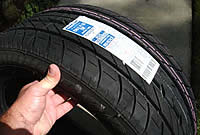 |
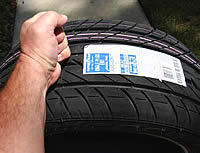 |
|
| One physical characteristic of any run-flat is a sidewall that is more stiff than that of a non-run flat tire. Image: Author |
Additionally, most of the casing, including the tread itself will be more stiff than that of regular tires. This stiffness is easily felt when handling any run-flat. Image: Author |
I wanted to test a C5 with a flat run-flat to see what EMTs were like when driven after a typical puncture. Some Corvette pals of mine, Mike and Crescent LoMonoco, own a 2001 Targa and were willing to help me with this test. Mike brought his ’01 over to the shop where I had him drive an awl though the tread of his left rear EMT. Pulling it out left a 1/8-in. hole.
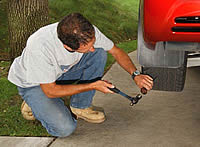 |
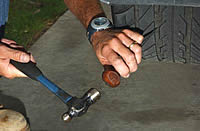 |
|
| To test the actual performance of a run-flat, running flat, I had C5 owner, Mike LoMonoco, pierce the left rear EMT on his car. Image: Author |
Ouch! Betcha haven’t seen many people do this. Making holes in EMT’s is best done with a sharp awl and a hammer. Trust me. Those tires are pretty tough. Image: Author |
Once tire pressure reached zero, Mike and I spent part of an afternoon driving the car around town along with doing ten miles on the freeway at 55-mph. In maneuvers you’d perform during normal driving, it was virtually impossible to feel any difference in the car’s handling, however, I could feel a slight difference in some low frequency ride movements. Another clue that I was running the left rear run-flat flat was the characteristic, rumbling noise EMTs make when they are driven deflated at slow speeds.
I took some temperature measurements using my Raytek Autopro, non-contacting IR thermometer right where the tread and the sidewall meet. The right rear measured 100-108°F. The flat, left rear ran 150-155°F in city driving and got to 170°F after ten miles on the highway. While it’s clear that flexing of the EMTs sidewalls caused a significant temperature increase, Goodyear told me that the critical area for temperature is not the tread but is on the inside of the tire casing. About 300°F on the inside of the tire is Goodyear’s safe limit. The Goodyear engineers added that, while during operation with no air, the tread temperature would always be less than the temperature sustained inside the casing, my 170° readings were still far below what the tread would attain if the internal temperature reached the 300°F range.
In short, Goodyear seems to have designed quite a temperature safety margin into EMTs. Quieter and more compliant run-flats might run even higher temperatures. Since temperature is the eventual undoing of any tire, the obvious speculation is that softer run-flats can’t run flat as far.
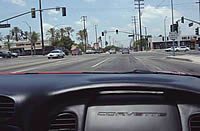 |
 |
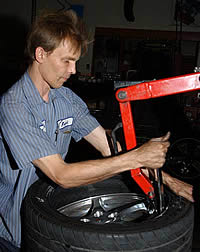 |
||
| We ran one of Mike tires flat for a little over 50 miles of round-town and freeway driving. Image: Author |
At the end of the fifty miles we took the left rear off and had it repaired. Image: Author |
Tucker Tire’s Frank Wright dismounts the tire. Image: Author |
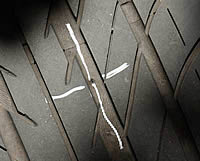 |
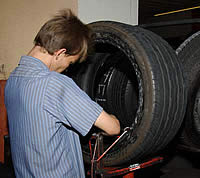 |
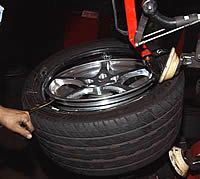 |
||
| Frank marked the hole. It was of the type that Goodyear says can be repaired. Image: Author |
Here, Wright performs the patching procedure... Image: Author |
...and then remounts the tire. Image: Author |
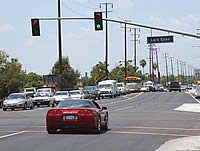 |
| After the repair Mike LoMonoco’s EMT drove just like it did before we hammered an awl through it. Image: Author |
Back at the shop, after a 51.6-mi. test, Mike LoMonoco and I pulled the left rear and took it to Tucker Tire Service, a Goodyear Dealer in Covina, California, for repair. One of Tucker’s most experienced tire technicians, Frank Wright, dismounted the tire, patched it, remounted it and re-inflated it.
After repair, the left rear EMT on the LoMonoco’s 2001 drove as if nothing had happened at all. After testing the no-longer-flat, run-flat tire for a while, I turned the car back over to Mike who took the car back to his home. That repaired EMT remained service on that ’01--which wife, Crescent, drives daily--for another 3450 miles which included a trip with Mike and Crescent’s club, Corvette Club Santa Barbara, where there were times when they were driving as fast as 112 mph and a round-trip to Las Vegas, Nevada in 108° summer heat. The tire was finally replaced when Mike installed a new set of F1 GS EMTs.
Could we run the same test on any other run-flat tire on the market for C5s? Wondering about that, as well as if noise and ride improvements by some aftermarket run-flats come at the expense of actual run flat performance, I contacted Michelin North America. According to spokesperson, Phil Romba, the Michelin Pilot Sport A/S Zero Pressure is rated for 50 run-flat miles at 55-mph and is repairable in a manner similar to that of the Goodyear. Next, I contacted Tiffany Bryant, spokesperson for Bridgestone/Firestone USA, and Dan Guiney, spokesperson for Yokohama Tire Company. They told me that the Firestone SZ50EP RFT and the Yokohama AVS Sport Run-Flat are, also, rated for up to 50 miles of 55-mph run-flat operation, however, after any run-flat incident, neither can be repaired and both must be scrapped.
None of the aftermarket run-flats for ’97-’04 Vettes are capable of going 200 miles deflated. That got my attention because it means that neither the Michelin Pilot Sport A/S Zero Pressure, the Firestone SZ50EP RFT or the Yokohama AVS Sport Run Flat meet General Motors specifications for C5 tires
I contacted Michelin North America, Bridgestone/Firestone USA and Yokohama Tire Company a second time to ask: 1) why their run-flats do not meet the vehicle manufacturer’s tire specification and 2) are those purchasing run-flats for Corvettes advised of that situation.
All three companies had three weeks to respond but chose not to answer by our deadline.
We can only wonder why Michelin, Firestone and Yokohama products are unable to go the 200 miles GM specifies. Is it because the aftermarket is unable to duplicate some engineering, materials or manufacturing processes used by Goodyear? To reduce noise and improve ride, are Firestone and others using less-stiff casings which might compromise deflated handling and durability?
If those purchasing aftermarket run-flats aren’t told what they’re buying is incapable of the same performance as what came on the vehicle; why aren’t they? Again, because Michelin, Firestone and Yokohama never responded, we can only speculate. Perhaps, if some customers were aware of the facts, they might not make the purchase and that could be an incentive to not disclose such information.
So what does all this mean for C5 owners intent upon purchase of replacement, run-flat tires? It means: if you want the same performance under run-flat conditions you had when your car was new, your choice is simple: the Goodyear Eagle F1 GS-EMT because it’s the only run-flat which meets General Motors specifications for safety and longevity of extended mobility tires.
This doesn’t mean one should not consider less expensive, aftermarket alternatives. As long as one understands the compromises in run-flat performance and durability, in some situations, they may be desirable. The best choice among the 50-mile run-flats is the Michelin Pilot Sport A/S ZP, because it’s the only one approved by its manufacturer for repair after run-flat operation. At least with the Michelin, if you have a repairable flat; you don’t have to throw away the tire.
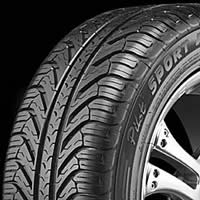 |
| The Michelin Pilot Sport A/S Zero Pressure. Image: Michelin N.A. |
In a practical sense, even the Firestone and the Yokohama can be reasonable choices, as long as you confine your driving to areas reasonably close to their dealers, you understand that any run-flat incident means buying another tire and you’re willing to tolerate any handling compromise you might experience. If those are acceptable tradeoffs, then aftermarket replacements, because they are sometimes less expensive, might be somewhat quieter and may ride a little less harshly.
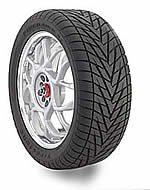 |
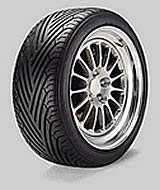 |
|
| The Firestone SZ50 EP RFT. Image: Bridgestone/Firestone, USA |
The Yokohama AVS Sport Run-Flat. Image: Yokohama Tire Co. |
On the other hand, if you travel through more remote areas in your C5 and you have a flat tire; potential deflated driving distance may exceed the 50-mile capability of aftermarket run-flats, so you may want to consider their purchase cautiously.
In closing, if you own a car with EMTs, and you’re thinking of replacing O.E. tires with aftermarket run-flats; know the facts and consider any compromises in run-flat performance and durability because...not all run-flats run flat alike.